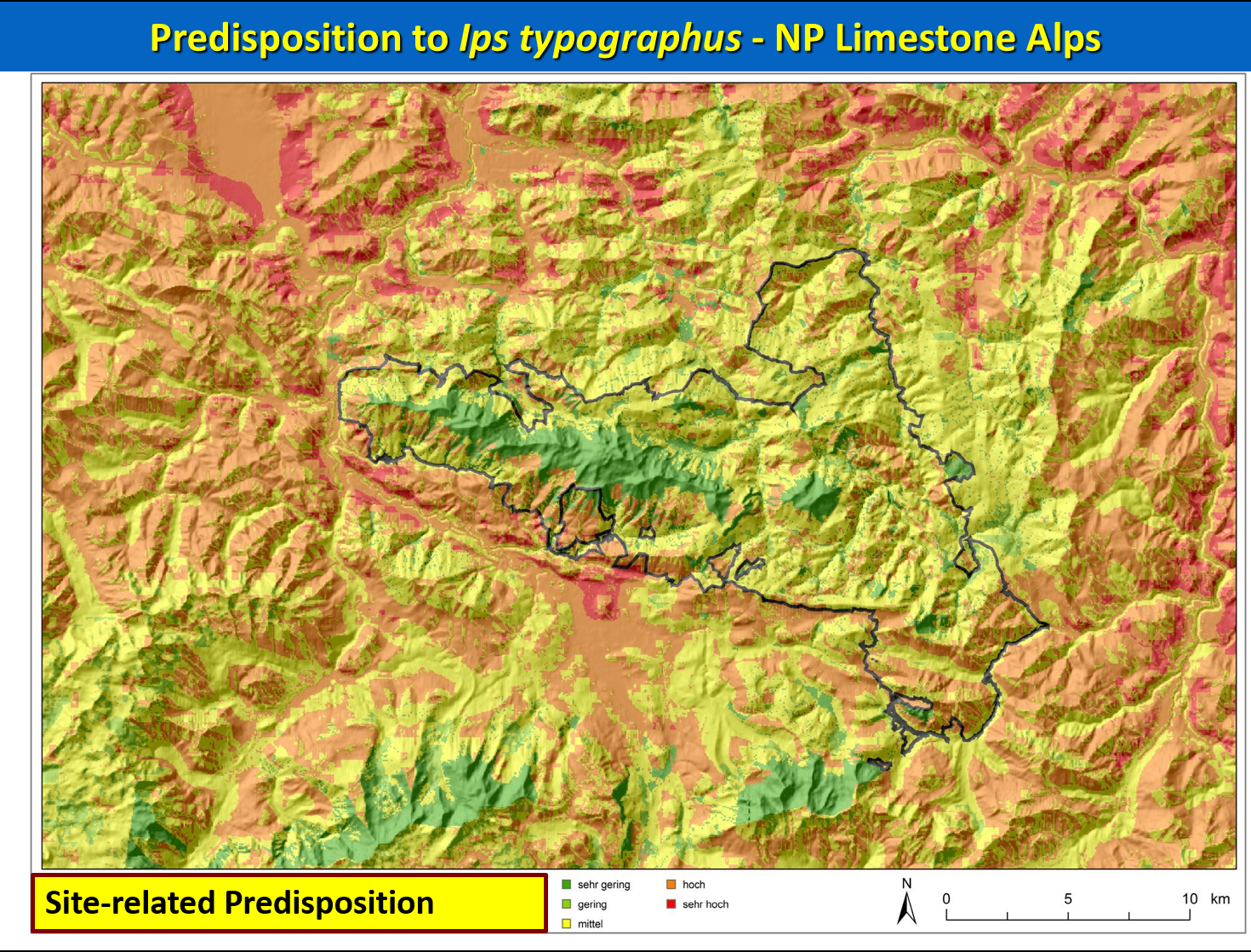Predisposition Assessment (PAS)
Concept of Risk and Predisposition
The genesis of forest damages relies on the spatial and temporal coincidence of disturbance factors (triggers) and susceptible, predisposed forest trees (Fig.1; Manion, 1991). Risk is related to external factors such as climate parameters or internal drivers like pest population dynamics, susceptibility (i.e. how easily the forest ecosystem is damaged by the disturbance agent as well as the values that are at stake (Jactel et al., 2009). As opposed to the occurrence of potentially damaging external factors, forest stand susceptibility can be, at least partly, controlled by management via silvicultural measures. (Führer and Nopp, 2001; Netherer and Nopp-Mayr, 2005). In order to decrease the risk of future damage having large detrimental impacts on forest functions/ecosystem services, a clearer understanding of causalities and how management decisions influence forest susceptibility to various disturbance agents is needed (Jactel et al., 2009).
Predisposition Assessment System (PAS)
Knowledge-based expert models meet the need for comprehensive tools which clearly demonstrate the opportunities for and limits of damage prevention for various biotic and abiotic disturbance factors. For this purpose, indicators that are typical criteria of forest management decisions, such as site factors and stand structural characteristics are applied. Following the ‘‘award penalty point systems’’ of Berryman (1986) and Speight and Wainhouse (1989), key factors for the predisposition of forests to respective disturbance factors were identified, based on an extensive literature research/ analysis and expert discussions. Based on the outcomes of this iterative process, empirical weighting numbers and predisposition points (i.e. penalty points) were attributed to the predisposition indicators. When applying the assessment system to inventory data of forest sites or stands, the predisposition values of the indicators are summed up. The result or sum of the predisposition values is related to the maximum of predisposition achievable within the system, and the resulting percentage is interpreted as the relative predisposition level of the assessment unit (comp. Netherer and Nopp-Mayr, 2005).
PAS – Eurasian Spruce Bark Beetle Ips typographus
Fig. 2 provides a summary of the most important indicators of forest predisposition to I. typographus attack. Weighting of site and stand-related parameters is demonstrated in tabular and graphical form (example water supply) by Fig. 3. Maps are convenient tools to illustrate regional attack hazards (Fig. 4).
References
Berryman A.A. 1986. Forest Insects. Principles and Practice of Population Management. Plenum Press, New York/London.
Führer E., Nopp U. 2001. Ursachen, Vorbeugung und Sanierung von Waldschäden. Facultas-Univ. Verlag, Wien, 514 S.
Jactel H., Nicoll B.C., Branco M., Gonzalez-Olabarria J.R., Grodzki W., Langström B., Moreira F., Netherer S., Orazio C., Piou D., Santos H., Schelhaas M.J., Tojic K., Vodde F. 2009. The influences of forest stand management on biotic and abiotic risks of damage. Ann For Sci 66: 1–18.
Manion P.D. 1991. Tree Disease concepts. Prentice Hall, Englewood Cliffs, NJ.
Netherer S., Nopp-Mayr U. 2005. Predisposition assessment systems (PAS) as supportive tools in forest management—rating of site and stand-related hazards of bark beetle infestation in the High Tatra Mountains as an example for system application and verification. For Ecol Manage 207, 99–107.
Speight M., Wainhouse D. 1989. Ecology and Management of Forest Insects. Clarendon Press, Oxford.

Fig. 1: Predisposition of forest stands to disturbance, which can be influenced by forest management, as important component of risk (after Jactel et al., 2009)

Fig. 2: Indicators of forest predisposition

Fig. 3: Weighting of site and stand-related parameters

Fig. 4: Map of regional attack hazards